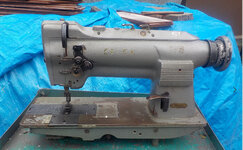I know there are a lot of guys here who make a lot of gear. Machines are always a big part of the picture. I want some advice on where to go if you all can help out.
I currently have a Consew 206-RB5 walking foot industrial. I put a servo motor on it. It sews fine on heavy stuff. It sucks for anything light. I also have several older home machines - a Kenmore, a Viking, and a singer 201-2 in it's original table. I rewired the singer and they all "work" Not great all the time - probably need more service than I have done.
I am thinking of ditching all of them and starting with a new machine. Something more versatile than heavy duty only. I have been looking into a needle feed machine or maybe just go with a Juki 8700H. I just really don't enjoy trying to sew much on the Consew, its like sewing with a jack hammer..lol It also makes stitches so tight you can't rip them out if you make a mistake!!
I have sewn clothing, tarps, bivy, canvas, webbing etc in the past. Heavy wool in some clothes, I made a tree saddle with seatbelt webbing. I find I really am going to lighter weight stuff. There might be the occasion still for multiple layers of heavier stuff though. I have watched multiple vids of the 8700 H sewing stuff thicker than I most likely will again. Like 14 layers of vinyl.
It looks like a needle feed is between the Consew and the regular straight stitcher. Is it worth it over the 8700H? I have read from some a needle feed is their most used machine.
So, what do Y'all think would be a good all arounder that will be easier to sew with??
Thanks!
I currently have a Consew 206-RB5 walking foot industrial. I put a servo motor on it. It sews fine on heavy stuff. It sucks for anything light. I also have several older home machines - a Kenmore, a Viking, and a singer 201-2 in it's original table. I rewired the singer and they all "work" Not great all the time - probably need more service than I have done.
I am thinking of ditching all of them and starting with a new machine. Something more versatile than heavy duty only. I have been looking into a needle feed machine or maybe just go with a Juki 8700H. I just really don't enjoy trying to sew much on the Consew, its like sewing with a jack hammer..lol It also makes stitches so tight you can't rip them out if you make a mistake!!
I have sewn clothing, tarps, bivy, canvas, webbing etc in the past. Heavy wool in some clothes, I made a tree saddle with seatbelt webbing. I find I really am going to lighter weight stuff. There might be the occasion still for multiple layers of heavier stuff though. I have watched multiple vids of the 8700 H sewing stuff thicker than I most likely will again. Like 14 layers of vinyl.
It looks like a needle feed is between the Consew and the regular straight stitcher. Is it worth it over the 8700H? I have read from some a needle feed is their most used machine.
So, what do Y'all think would be a good all arounder that will be easier to sew with??
Thanks!

